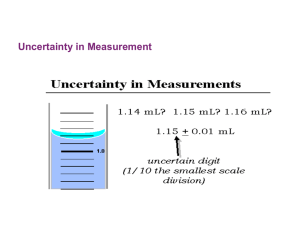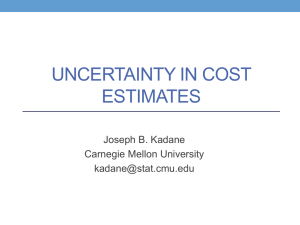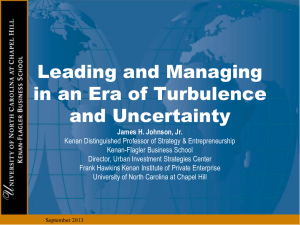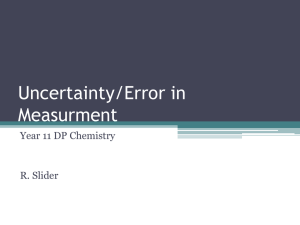Uncertainty and Significant Figures
advertisement
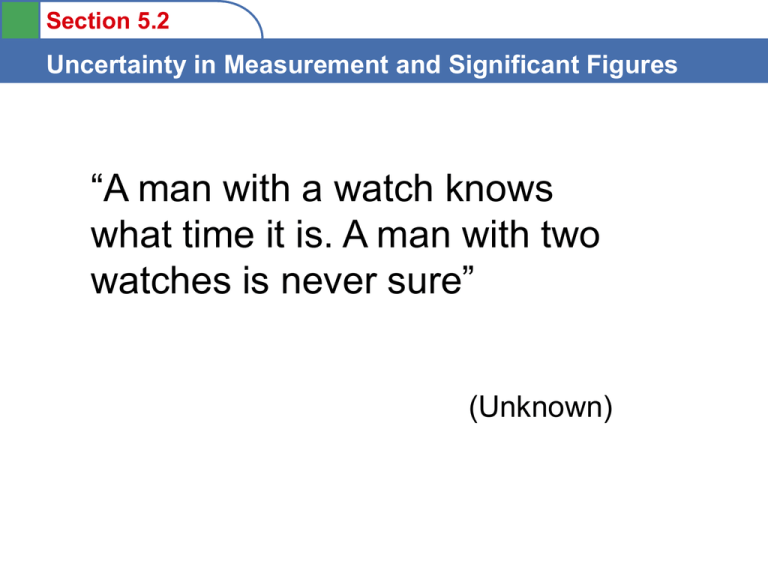
Section 5.2 Uncertainty in Measurement and Significant Figures “A man with a watch knows what time it is. A man with two watches is never sure” (Unknown) Section 5.2 Uncertainty in Measurement and Significant Figures I weigh some sugar on my kitchen scales and some more sugar on my lab balance. The results are shown below. How much sugar should I say I have, in total, without being misleading? Kitchen scales: 2.2 kilograms Lab scale: 101.237grams (1kg = 1000g) Section 5.2 Uncertainty in Measurement and Significant Figures Section 5.2 Uncertainty in Measurement and Significant Figures B. Significant Figures • Significant figures are the meaningful figures in our measurements and they allow us to generate meaningful conclusions • Numbers recorded in a measurement are significant. – All the certain numbers plus first estimated number e.g. 2.85 cm • We need to be able to combine data and still produce meaningful information • There are rules about combining data that depend on how many significant figures we start with……… Section 5.2 Uncertainty in Measurement and Significant Figures B. Significant Figures Rules for Counting Significant Figures 1. Nonzero integers always count as significant figures. 1457 has 4 significant figures 23.3 has 3 significant figures Section 5.2 Uncertainty in Measurement and Significant Figures B. Significant Figures Rules for Counting Significant Figures 2. Zeros a. Leading zeros - never count 0.0025 2 significant figures b. Captive zeros - always count 1.008 4 significant figures c. Trailing zeros - count only if the number is written with a decimal point 100 1 significant figure 100. 3 significant figures 120.0 4 significant figures Section 5.2 Uncertainty in Measurement and Significant Figures B. Significant Figures Rules for Counting Significant Figures 3. Exact numbers - unlimited significant figures • Not obtained by measurement Determined by counting: 3 apples Determined by definition: 1 in. = 2.54 cm Section 5.2 Uncertainty in Measurement and Significant Figures How Many Significant Figures? 1422 102 65,321 102.0 1.004 x 105 1.02 200 0.00102 0.10200 435.662 50.041 1.02 x 104 1.020 x 104 60 minutes in an hour 500 laps in the race Section 5.2 Uncertainty in Measurement and Significant Figures B. Significant Figures - Round off 52.394 to 1,2,3,4 significant figures Section 5.2 Uncertainty in Measurement and Significant Figures B. Significant Figures Rules for Multiplication and Division • I measure the sides of a rectangle, using a ruler to the nearest 0.1cm, as 4.5cm and 9.3cm • What does a calculator tell me the area is? • What is the range of areas that my measurements might indicate (consider the range of lengths that my original measurements might cover)? Section 5.2 Uncertainty in Measurement and Significant Figures B. Significant Figures Rules for Multiplication and Division • The number of significant figures in the result is the same as in the measurement with the smallest number of significant figures. Section 5.2 Uncertainty in Measurement and Significant Figures B. Significant Figures Rules for Addition and Subtraction • The number of significant figures in the result is the same as in the measurement with the smallest number of decimal places. Section 5.2 Uncertainty in Measurement and Significant Figures Rules for Combined Units • Multiplication / Division – When you Multiply or Divide measurements you must carry out the same operation with the units as you do with the numbers 50 cm x 150 cm = 7500 cm2 20 m / 5 s = 4 m/s or 4 ms-1 16m / 4m = 4 • Addition / Subtraction – When you Add or Subtract measurements they must be in the same units and the units remain the same 50 cm + 150 cm = 200 cm 20 m/s – 15 m/s = 5 m/s Section 5.2 Uncertainty in Measurement and Significant Figures Calculate the following. Give your answer to the correct number of significant figures and use the correct units 11.7 km x 15.02 km = 12 mm x 34 mm x 9.445 mm = 14.05 m / 7 s = 108 kg / 550 m3 = 23.2 L + 14 L = 55.3 s + 11.799 s = 16.37 cm – 4.2 cm = 350.55 km – 234.348 km =
